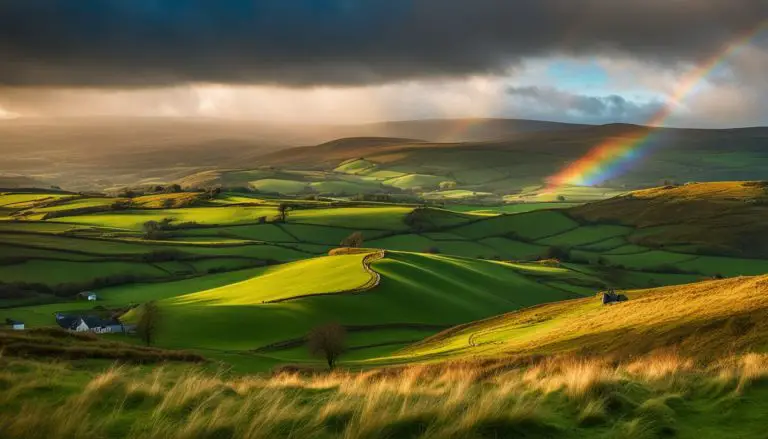What Language is Spoken in Ireland? A Guide to the Languages of Ireland
Ever wondered what echoes through the rolling hills and bustling cities of the Emerald Isle? I found myself pondering that very question, and let me tell you, it’s a delightful linguistic adventure; Ireland is home to not one, but two official languages! As I delved into Ireland’s rich verbal heritage, I discovered a treasure trove of phrases and idioms just waiting to be shared.
So why not join us on this journey? Our guide is your passport to the captivating chorus of voices that make up Ireland’s unique cultural melody.
Key Takeaways
- Ireland has two official languages, Irish Gaelic and English. Most people speak English, but Irish is special to the culture.
- In parts of Ireland called Gaeltacht areas, people speak Irish daily. Everywhere else, you will mostly hear English.
- You’ll find signs in both English and Irish all over the country. Schools teach Irish too.
- Other languages spoken include Ulster Scots, Shelta, and immigrant languages like Polish and French.
- Efforts are being made to keep the Irish language strong through teaching it in schools and using it on signs.
The Official Languages of Ireland
Ireland has two official languages: Irish (Gaelic) and English. While English is the most widely spoken language, Irish holds a special cultural significance and is actively promoted in certain regions of the country known as Gaeltacht areas.
Irish
Irish Gaelic is one of Ireland’s official languages, and it holds a special spot in the heart of Irish culture. You’ll often hear it called just “Irish.” In some parts of the country, especially the Gaeltacht regions, people speak Irish as their first language.
While visiting these areas, I’m surrounded by its unique sounds and expressions – it’s like stepping into a living piece of history! But don’t worry if you’re not fluent; everyone speaks English too.
This beautiful Celtic language isn’t just for locals. It’s taught in schools all over Ireland and you’ll see road signs in both Irish and English. When traveling through Ireland, I love picking up a few phrases – it helps me connect with local traditions.
The language has deep roots dating back thousands of years and hearing it gives you a true taste of Irish heritage.
English
Ireland has two official languages: Irish (Gaelic) and English. English is the primary language for 95% of the population in Northern Ireland, where it’s recognized as an official language.
In fact, English is still the first and most commonly spoken language for the majority of the population in both Northern Ireland and Ireland as a whole. While Irish Gaelic is commonly spoken in certain regions known as Gaeltacht areas, especially along the western coast, travelers can rest assured that English will be widely understood throughout their visit to Ireland.
Other Languages Spoken in Ireland
In addition to Irish and English, Ireland is also home to other languages such as Ulster Scots, Shelta, and various immigrant languages like Polish, French, German, and Portuguese.
These languages contribute to the diverse linguistic landscape of Ireland and reflect the rich cultural heritage of the country.
Ulster Scots
Ulster Scots is a distinct dialect spoken in Northern Ireland, influenced by the Scots language. It has official recognition in Northern Ireland as a minority language. The Ulster-Scots Agency promotes and preserves this unique linguistic heritage through various cultural initiatives and educational programs, offering travelers an opportunity to explore the rich linguistic diversity of the region.
Shelta
Shelta, also known as the Cant or Gammon language, is a secret language often associated with Irish Travellers. This cryptic and historically significant tongue combines elements of Irish and English.
Shelta
Shelta is a secret language used by the Irish Traveller community. It has its roots in Ireland and incorporates elements of Gaelic and English languages. Shelta developed as a way for the Travellers to communicate discreetly, often used within their close-knit communities.
This unique language reflects the rich cultural heritage of Ireland and adds an intriguing layer to the linguistic diversity found in this beautiful country.
The next aspect we’ll explore is “Immigrant Languages” spoken in Ireland, such as Polish, French, German, Portuguese among others.
Immigrant languages (Polish, French, German, Portuguese)
Immigrant languages such as Polish, French, German, and Portuguese are increasingly spoken in Ireland due to the growing immigrant population.
- Polish is the most widely spoken immigrant language in Ireland, with over 120,000 Polish nationals residing in the country.
- French is also prevalent, especially in urban areas and among international communities.
- German is commonly spoken within business and academic circles, particularly in Dublin and other major cities.
- Portuguese is becoming more prominent with the influx of Portuguese nationals seeking work opportunities in Ireland.
History and Evolution of the Irish Language
The Irish language has a rich history, with origins in prehistoric Celtic languages and a complex evolution over time. From its roots to modern usage, the language has played a significant role in Ireland’s cultural and linguistic identity.
Prehistoric languages
Prehistoric Ireland was home to various ancient languages spoken by early settlers. These languages, now extinct, have left their mark on the development of modern Irish Gaelic. The Celtic languages used by the first inhabitants greatly influenced the roots of the Irish language that we know today.
The evolution of these prehistoric languages has contributed significantly to the linguistic heritage and cultural identity of Ireland.
The early tongues spoken in prehistoric Ireland laid down the foundations for what would become the rich tapestry of language found in modern-day Ireland. The influences from these ancient languages are evident in Gaelic-speaking communities, adding depth and complexity to the linguistic landscape travelers encounter when visiting this fascinating land steeped in history and tradition.
Modern languages
Modern languages in Ireland include Ulster Scots, Shelta, and immigrant languages such as Polish, French, German, and Portuguese. English is the primary language for 95% of the population in Northern Ireland.
The Irish Gaelic language is recognized as an official language in both Northern Ireland and the Republic of Ireland. In the Gaeltacht regions, which are scattered mainly along parts of the western coast and on some islands, Irish remains a living community language.
In these areas, you’ll find that many people still speak Irish daily. However, for most travelers visiting urban centers or popular tourist destinations across Ireland, English will be the dominant language encountered.
Usage throughout history
Moving from the discussion of modern languages, it’s fascinating to note the rich history and evolution of the Irish language. Throughout Ireland’s long history, various prehistoric languages laid the foundation for the development of today’s Gaelic-speaking population.
The influence of invasions and colonization led to changes in language usage, with English becoming prevalent over time despite efforts to preserve traditional Irish traditions and language.
Despite this, significant efforts have been made in recent times to maintain and revive the use of Irish through education initiatives and cultural revitalization programs.
The historical usage patterns reveal a complex interplay between indigenous Gaelic-speaking communities and external influences that shaped Ireland’s linguistic landscape over time.
The Current State of the Irish Language
Irish is spoken in daily life, with various dialects and urban usage, as efforts for standardization continue to evolve. Interested in discovering more about the rich linguistic landscape of Ireland? Keep reading to learn more!
Usage in daily life
In daily life, English is the primary language used by 95% of people in Northern Ireland. Irish, on the other hand, is spoken as a first language by only 2% of the population and mainly in areas known as Gaeltacht regions.
These are places where Irish traditions are still strong and where you can experience the Gaelic-speaking culture. Understanding a bit of Hiberno-English or some basic Irish phrases could make your trip more enriching when interacting with locals.
Moving to “Dialects,” let’s explore how these languages have evolved in different regions.
Dialects
Despite its small population, Ireland has various dialects of the Irish language. Here are some key variations to be aware of:
- Connacht Dialect: Spoken in western Ireland, this dialect is known for its distinct pronunciation and vocabulary.
- Munster Dialect: Hailing from southern Ireland, this dialect is easily recognizable due to its unique intonation and expressions.
- Ulster Dialect: Spoken in the northern part of the island, this dialect has its own set of grammatical rules and vocabulary.
Urban usage
In urban areas of Ireland, English is the predominant language spoken. While Irish Gaelic is recognized as an official language, its usage in cities like Dublin and Cork is limited compared to rural Gaeltacht regions.
The majority of the population residing in cities converse primarily in English, including interactions with tourists and visitors. However, there’s a growing interest in learning the Irish language among urban dwellers, supported by various cultural institutions and educational programs.
The urban usage of languages in Ireland reflects the modern multicultural society while also preserving its traditional linguistic heritage. Despite being predominantly English-speaking, travelers may still encounter signs and public services offered bilingually or have opportunities to engage with Irish speakers in select urban settings.
Standardization efforts
Efforts have been made to standardize the Irish language, ensuring consistency in its usage and preserving its heritage. The creation of the official standard written form of Irish aims to maintain linguistic purity and uphold the language’s cultural significance.
In Northern Ireland, measures are also in place to promote the standardization of both English and Irish as official languages, reflecting the region’s rich linguistic diversity.
The development of standardized Irish serves to safeguard its authenticity and facilitate broader comprehension for those interested in exploring this unique aspect of Irish culture during their travels throughout the island.
Conclusion
The official languages of Ireland are Irish and English. Other languages spoken in Ireland include Ulster Scots, Shelta, and immigrant languages such as Polish, French, German, and Portuguese.
The history and evolution of the Irish language encompass prehistoric and modern languages’ usage throughout history. Currently, only 2% of Ireland’s population resides in the Gaeltacht where Irish is spoken as a first language.
The current state of the Irish language involves its usage in daily life, various dialects, urban usage, and standardization efforts.
Irish is recognized as an official language in Northern Ireland, while English remains the primary language for the majority of the population there. In conclusion: English and Irish Gaelic are significant to understand when visiting or living in Ireland; they reflect both cultural heritage and modern communication needs.







